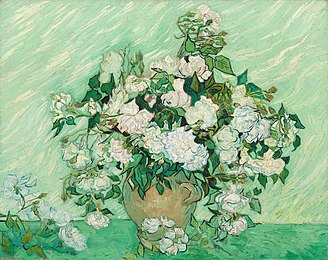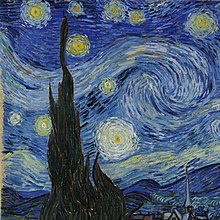Art Technique of Using Short Brushtrokes With a Lot of Paint

Impasto is a technique used in painting, where paint is laid on an area of the surface thickly,[1] usually thick enough that the brush or painting-knife strokes are visible. Paint can also be mixed right on the canvas. When dry out, impasto provides texture; the pigment appears to be coming out of the canvass.
Origins [edit]
The word impasto is Italian in origin; in which it means "dough" or "mixture"; related to the verb impastare, "to knead", or "to paste". Italian usage of impasto includes both a painting and a potting technique. According to Webster'due south New World Higher Lexicon, the root noun of impasto is pasta , whose master meaning in Italian is "paste".[2]
Mediums [edit]
Oil pigment is the traditional medium for impasto painting, due to its thick consistency and slow drying fourth dimension. Acrylic paint can also be used for impasto by adding heavy torso acrylic gels. Impasto is more often than not not used in watercolor or tempera without the improver of thickening agent due to the inherent thinness of these media. An artist working in pastels can produce a limited impasto effect past pressing a soft pastel firmly confronting the newspaper.
Purposes [edit]
The impasto technique serves several purposes. First, information technology makes the low-cal reverberate in a detail mode, giving the artist additional control over the play of light in the painting. Second, it can add expressiveness to the painting, with the viewer being able to notice the strength and speed by which the artist applied the paint. Tertiary, impasto can button a piece from a painting to a 3-dimensional sculptural rendering. The first objective was originally sought by masters such as Rembrandt, Titian, and Vermeer, to represent folds in clothes or jewels: it was then juxtaposed with a more than fragile painting way. Much later, the French Impressionists created pieces covering entire canvases with rich impasto textures. Vincent van Gogh used it oft for aesthetics and expression. Abstract expressionists such as Hans Hofmann and Willem de Kooning also made extensive use of it, motivated in part by a desire to create paintings which dramatically record the action of painting itself. Still more recently, Frank Auerbach has used such heavy impasto that some of his paintings get nearly three-dimensional.
Impasto gives texture to the painting, significant it tin be opposed to more flat, polish, or blended painting styles.
Artists [edit]
Many artists have used the impasto technique. Some of the more than notable ones including: Rembrandt van Rijn, Diego Velázquez, Vincent van Gogh, Jackson Pollock, and Willem de Kooning.
- Selected examples of paintings which make use of the impasto technique
| | Taos Mount, Trail Home past Cordelia Wilson (1920). A mural entirely executed with a bold impasto technique. | |
| Starry Night by van Gogh (1889). The impasto technique and line structure gives his viewers the feeling that the sky is moving.[iii] | Self Portrait past Rembrandt (1660). His use of impasto was surely inspired by Titian, and the addition of impasto showed a new method of illusion in the creative person's work.[4] |
Run across besides [edit]
- List of art techniques
References [edit]
- ^ Impasto. In: Weyer, Angela; Roig Picazo, Pilar; Pop, Daniel; Cassar, JoAnn; Özköse, Aysun; Jean-Marc, Vallet; Srša, Ivan (Ed.) (2015). Weyer, Angela; Roig Picazo, Pilar; Popular, Daniel; Cassar, JoAnn; Özköse, Aysun; Vallet, Jean-Marc; Srša, Ivan (eds.). EwaGlos. European Illustrated Glossary Of Conservation Terms For Wall Paintings And Architectural Surfaces. English Definitions with translations into Bulgarian, Croation, French, German language, Hungarian, Italian, Polish, Romanian, Spanish and Turkish. Petersberg: Michael Imhof. p. 100. doi:x.5165/militarist-hhg/233.
- ^ Webster's New World dictionary of the American linguistic communication. Guralnik, David B. (David Bernard), 1920-2000. (New rev., expanded pocket-size ed.). New York, Northward.Y.: Warner Books. 1982. ISBN0446311928. OCLC 10638582.
{{cite book}}: CS1 maint: others (link) - ^ Naifeh, Steven, 1952- (2011). Van Gogh : the life. Smith, Gregory White. (1st ed.). New York: Random Firm. ISBN9781588360472. OCLC 763401387.
{{cite book}}: CS1 maint: multiple names: authors list (link) - ^ Walter Liedtke, Carolyn Logan, Nadine M. Orenstein, Stephanie S. Dickey, "Rubens and Rembrandt: A Comparison of Their Techniques," Rembrandt/not Rembrandt in the Metropolitan Museum of Art, New York: Metropolitan Museum of Fine art, 1995.
External links [edit]
-
 Media related to Impasto (painting) at Wikimedia Commons
Media related to Impasto (painting) at Wikimedia Commons - Lindberg, Ted. Alfred Currier: Impasto
- National Portrait Gallery, London. Impasto
- Tate United kingdom Gallery, London. Frank Auerbach, Bacchus & Ariadne.
Source: https://en.wikipedia.org/wiki/Impasto




0 Response to "Art Technique of Using Short Brushtrokes With a Lot of Paint"
Postar um comentário